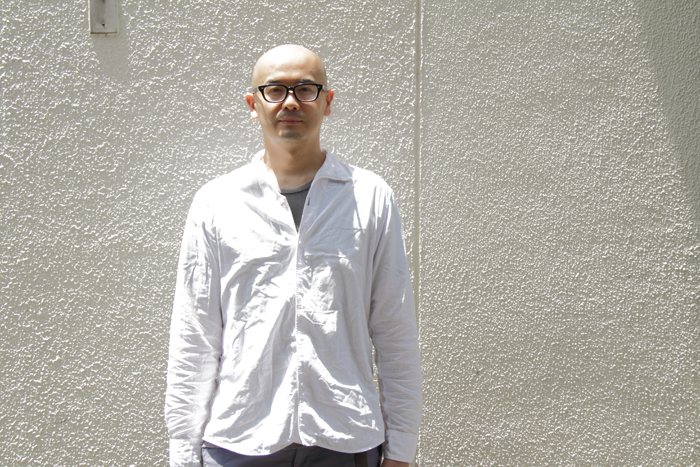森岡督行さん(森岡書店店主)
「本」と「古き良きもの」との出会い
小さい頃からもともと本が好きだった森岡さんだが、とりわけ中学生の頃からは、男性ファッション誌や情報発信誌に魅せられていったと言う。当時はインターネットが生活の隅々にまで浸透しているわけではなかったので、『BRUTUS』『POPEYE』(ともにマガジンハウス)『MEN’S NON-NO』(集英社)や、いまは廃刊になってしまった『Check Mate』『Hot-Dog PRESS』(ともに講談社)といった雑誌を毎月吟味しながら買い求めるのが愉しみだった。山形県寒河江市で生まれ育った森岡さんにとって、雑誌に掲載されているアイテムやイベントはどこか遠くのほうにあって、その憧憬を胸に年に数回東京に遊びに出かけたりしていた。この頃から、雑誌という媒体への興味はさることながら、そこに紹介されていた洋服や小物類のかたちや、それらを着こなすモデルたちに心を動かされていく。 文芸書や専門書に強く心ひかれるようなったのは、進学した大学の近所だった神保町をよく散歩するようになってからのこと。しかし、本を愛する一方で、環境問題にも関心が高かった森岡さんは、ただやみくもに物を生産して消費する経済活動に心の底から共感できないでいた。とはいえ、大学卒業後は何らかのかたちで社会に従事しなくてはならないと思っていたし、どうしたものかと進路について考えていた折、朝日新聞に掲載されていた神保町の古書店『一誠堂書店』の求人広告が、森岡さんの目に飛び込んできた。一誠堂書店には、森岡さんが好きなものがすべて集約されていた。好きなものというのは「本」と「古い建物」。古本なら、いまあるものをリサイクルしていくという観点からも環境保全にもつながる職業だと思えた。とりわけ後者については、昭和初期に建てられた『旧東京宝塚劇場』の建築物が好きで、アルバイトをしていたこともあるくらいの懲りようだ。一誠堂書店の建物も1931年(昭和6年)に竣工された当時としては珍しい5階建ての鉄筋コンクリート造り。1998年に見事狭き門をくぐり抜け、創業110年の老舗、一誠堂書店に入社した。 一誠堂書店での仕事は、その後の森岡さんの人生の礎となっている。本の知識や本屋としての姿勢という点でも、大変勉強になる恵まれた環境だった。入社当初は、お客さまから訊かれる本があまりにも専門的で、すぐに対応することができなかったこともあったと言う。そんなときに寛大な社長が指示してくれた仕事に「落丁調べ」という業務があった。新しく仕入れられた本のページを一枚ずつめくりながら抜け落ちているページがないかどうかを確かめる作業で、著者や内容を大まかに把握し、店で扱う書籍を知識として身につけることができた。お客さまから訊かれる問い合わせに日々対応しながら「古本屋の修行」を積んでいく。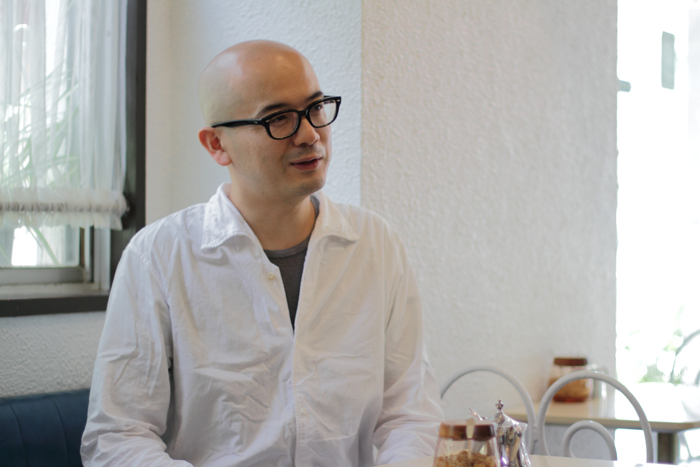
森岡さんが一誠堂書店に務めていた頃、夕方の休憩時間に足繁く通ったという高級洋菓子店『柏水堂』にて。
好きなものによって拓かれた自分の場所
定年まで一誠堂書店に務めようと思っていた森岡さんに、2006年、千載一遇の話が舞い込んできた。いまの森岡書店が入っている戦前の古いビルの一室を、頑張れば借りることができるかもしれないという、森岡さんにとってはまたとない機会だった。東京に残っている戦前の建物は少ないながらもいくつかあるが、各階の天井が高いことや壁の質感、隣りに河が流れていることなど、森岡さんが大切にしたい条件はほかの物件にはなく、強く突き動かされるような感覚とともに心が揺らいだ。 「本屋をやりたいとか、経営的なことを考える以前に、この場所に出会ってしまったことで、何かをやりたくなったというのが、そのときの率直な感覚です。場所があるという前提でできることを考えたときに、一誠堂書店で働いていた時代からお客さまと話をできるのがとても好きだったし、お客さまに僕の知らないことを教えていただいたという経験が土台となっていました。そんなことから書店というリアルな店舗を構えるに至ったのだと、いまにしてみれば思います。僕にとってはお客さまを迎える場所があるということがとても大切だったのです」 さまざまな縁が縁を呼び、本を生業とすることになった森岡さんにとって本とはどのような存在なのだろうか? 「本屋としての本は、生活の糧をつくるものでもあるし、コミュニケーションの手段だと思っています。本を介していろいろな方と話ができたり、展示ができたりすることで、世界観が広がったと思います。僕個人としては、知識を得るのにとても便利なツールだし、いまの僕の基礎であり、これからもそうあり続けると思います」 森岡さんが影響を受けた本は数多とあるなかで、決定的な出会いとなったのは「対外宣伝グラフ誌」だった。自身の著書『BOOKS ON JAPAN 1931-1972 日本の対外宣伝グラフ誌』(ビー・エヌ・エヌ新社)で取りあげられているものは、『NIPPON』(日本工房)や『FRONT』(東方社)に代表される、国家の政治的、軍事的方針や文化水準を直接宣伝しているもののほかに、欧文で制作された観光宣伝、輸出製品のカタログ、博覧会のカタログ、オリンピック案内なども含まれる。 「2000年頃に一誠堂書店で初めて出会って以来、みるみるうちにのめり込んで、気づいたら身銭を切ってどんどん買い足していました。そのコレクションは商品も合わせると数千冊くらいになると思います。もちろん村上春樹作品をはじめ、読んで影響を受けた本はたくさんありますが、僕の人生そのものが巻き込まれていったというのは対外宣伝グラフ誌と言えます。まず、これだけ鮮烈なパワーを放つ誌面やエディトリアルデザインが戦時中につくられていたという事実に驚いたし、その時代背景が知りたくなりました。日本の写真やグラフィックデザイン史で偉業を残した名だたるクリエイターが起用され、いまでもそのクオリティを超える視覚メディアは存在しないと言われるほどです」 本や建物然り、古いものが幼い頃から好きだという森岡さん。これはどういう由来で僕のところに来たのだろうと、その背景にある物語を空想したりするのがたまらなく愉しいのだそうだ。小説家で仏文学者の堀江敏幸さんの著書『もののはずみ』に、要約すれば、「古いものそのものの面白さはもちろんだが、その背後にある物語が好きだ。ものは所有するだけでなく、ものがある空間のなかで自分を活かすときに、初めてそこから自分もはずんでいく」と書いてあって、森岡さん自身の感覚を見事に言葉にしてもらえたと、思わず膝を打ったと言う。本そのものが歩んできた物語とともに伝えたいこと
森岡さんが日常のなかで大変な出来事に遭遇したときに大切にしていることを訊ねてみると、こんな答えが返ってきた。 「高校時代に大好きで聴いていたBeatlesのアルバム『Abbey Road(アビイ・ロード)』に、Beatlesの最後の曲と言われる『The End(ジ・エンド)』という曲が収録されています。その最後の一節“And, in the end, the love you take is equal to the love you make.(結局、あなたが受けとる愛は、あなたが与える愛の量に等しい)”という言葉を、いまでもよく想い出します」 いかにも、言葉との出会いや、人々との出会いを大切にしている森岡さんらしい。 現在、『THREE TREE JOURNAL』の『A BOOK WORM』というコラムで、THREE TREE JOURNAL読者の心の栄養になるような書籍を、毎月2冊ずつご紹介いただいている。いつもどのように選ばれているのかを訊いてみると、「毎月、かなり熟考して選んでいます。前提として、僕が読んで感銘を受けている本であることは間違いありませんが、本の内容だけでなく、本そのものが歩んできた背景や、僕自身との関わり合いに物語があるものを紹介するようにしています」と森岡さん。 最後に、THREE TREE JOURNAL読者に向けてメッセージをいただいた。 「『THREE』のコンセプトは僕自身にも、とても共感できるものです。世の中は美しいものに満ちていて、たとえば道端に咲いている野花もそうですね。先日電車のなかで知り合いの女性にばったりと会って、彼女が微笑んだときにちらっと見えた歯科矯正がとてもかわいらしくて、その美しくあろうとする姿勢が素晴らしいし、愛おしいと僕は思います。心が豊かであれば、それが外身にも出てくるので、本屋を営む身としては心を豊かにしてくれる有効なツールとして、やはり本をおすすめしたい。日本は世界的にみても類例を見ない出版大国であり、古今東西の名作が手軽に読める環境にあることも幸せなことです。近年は書店文化が脚光を浴びるようになり、朗読会やトークショーといったイベントも盛んに行われるようになりました。本との関わり方が多様化してきたので、ぜひ積極的にそういった環境に足を運び、感受性を豊かにしていくことで、より美しくあってほしいと思います」 森岡さんの今後の活動として、新潮社が発行している『とんぼの本』のメールマガジン(無料)にて、毎月日記を連載しているほか、9月中旬から、岡山県倉敷市にあるデニムブランド『KAPITAL』児島店のリニューアルに際し、新たに併設される本屋のセレクトを手がけることになっている。また、同月、御茶の水と神田の間にあった旧万世橋駅にできる複合施設のライブラリーも担当する。11月には晶文社からエッセイ本も出版する予定だ。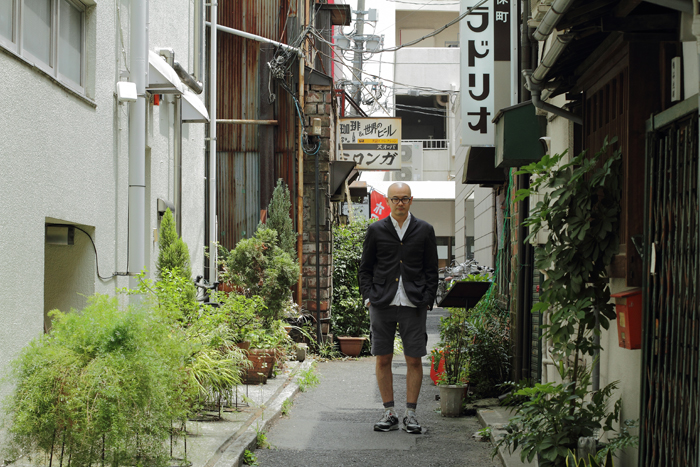
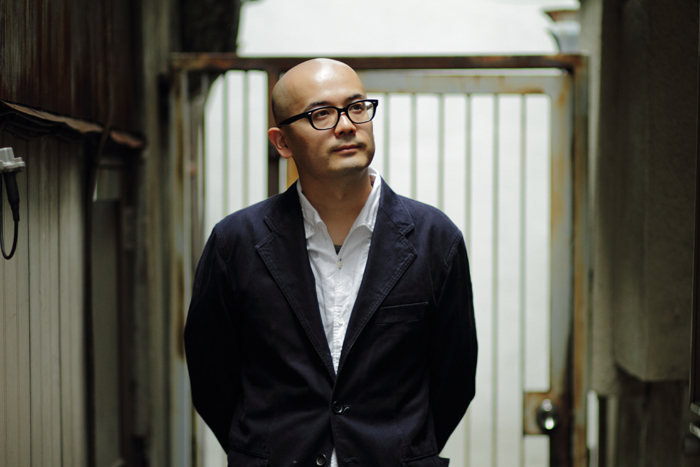
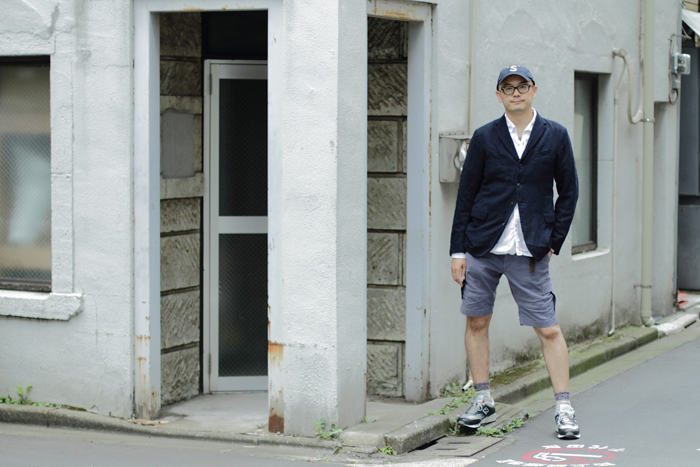
本や作品よりも店員が目立たないほうがいいというのが森岡さんの信条。一誠堂書店勤務時代から紺色のジャケットがユニフォームだったことに加え、本やギャラリーとの相性がいいという持論から、店に立つ時には紺色のジャケットを羽織ることに決めている。複数あるジャケットは、上から、『KATO`』、『ISSEY MIYAKE』、『ARTS&SCIENCE』
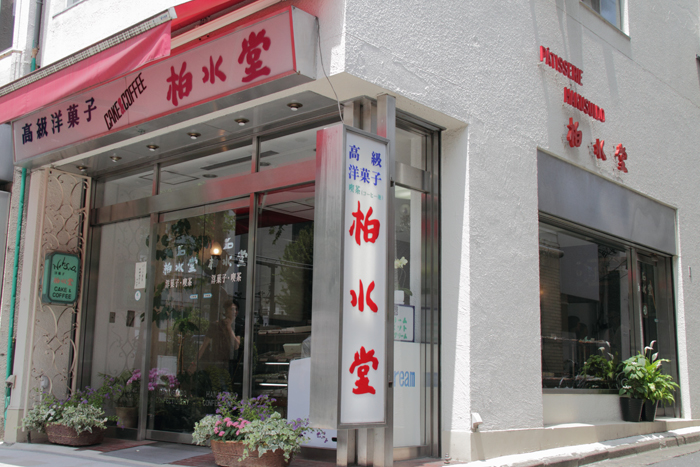
<柏水堂>
東京都千代田区神田神保町1-10 電話:03-3295-1208
営業時間:9:30-19:00 定休日:日曜・祝日
<クレジット>
PHOTOGRAPHS BY YUKI HOSHINO
SHOOTING LOCATION AT HAKUSUIDO
森岡督行さんの連載コンテンツ > A Book Worm
- Guest File #05
- “Books are effective tools to enrich your mind” Toshiyuki Morioka (Storekeeper of Morioka Shoten)
- THURSDAY, 15st AUGUST, 2013
His Encounter with Books and The Old and Good
Mr. Morioka loved books from the time he was a child. From the time he was in middle school he was especially drawn to mens' fashion and publishing magazines. At the time the internet hadn't infiltrated every corner of life, so every month he would enjoy buying and looking over such magazines as “BRUTUS”and “POPEYE” (both MAGAZINE HOUSE), “MEN'S NON-NO”(Shueisha) and the now no longer published “Check Mate”and “Hot-Dog PRESS” (both Kodansha). To the Sagae, Yamagata born and raised Mr. Morioka, the items and events featured in the magazines were somewhere far away, and he would go to Tokyo many times a year with adoration in his heart. More than his interest in the medium of magazines he was inspired by the clothes and the shapes of accessories introduced in there, the models who wore them. He was strongly drawn to books on literary art and specialty books after he started walking around Jimbocho often, near his University. On the other hand, he also took an increased interest in environmental problems, but he couldn't identify with the economic activity of blindly producing and consuming things. Even so, he knew he had to get a job at a company after graduating. While thinking over what his path would be, his eyes jumped to a wanted ad for the used bookstore Isseido Books in Jimbocho in the Asahi newspaper. Everything he loved was summarized by them. He loved books and old buildings. Used books seemed to be a job linking his view of recycling what people already had with maintaining the environment. About the latter, he liked the Old Tokyo Takarazuka Theater built in the early period and had worked there part-time so much that he was fed up. The Isseido building was also a steel 5-story concrete building rare at the time of its completion in 1931 (Showa 6). In 1998 he successfully passed and entered the 110-year-old Isseido Book store. His job at Isseido Books became the foundation for his later life. He was in an educational environment where he learned the approach of book retailers and his knowledge of books. When he first joined the company, the customers would ask him about books that were so specialized he couldn't immediately respond to them. In the job the generous company president had instructed to him, there was a duty called “missing page search”. His job was to flip through each page of newly stocked books to check if there were any pages coming off. He came to grasp the content and authors generally and to learn which books they carried in store. He 'trained for old books' while responding to inquiries from customers daily.His place developed from the things he liked.
Mr. Morioka had planned to work at Isseido Books until retirement when in 2006 he had the chance of a life time. He had the rare opportunity to rent a room in an old-prewar building, in which Morioka Shoten is now, if he worked hard. There are a few pre-war buildings left in Tokyo, and this real estate had such features as a flowing river nearby, the quality of the walls and high ceilings on all roofs. He wavered while feeling strongly moved. The desire to do something by having encountered this place previously thinking of businesses and wanting to run a bookstore was a straightforward sense. When I thought of the presupposition of having a place, I'd love being able to talk with customers since the time I had worked at Isseido Books, and my experience of having customers teach me things I didn't know was the base. Looking back on it now I believe that those were what prepared me for a real bookstore. It was very important for me to have a place to welcome customers.” Mr. Morioka's many connections called upon other connections, helping him to make books his livelihood. For him, what are books? “Books as a bookstore are both something to make bread and butter and a way of communication. My worldview has expanded through being able to introduce books and talk with many people and exhibiting them. Personally, they are a convenient tool to gain knowledge and are my foundation. I think they will continue to be so.” Among the many books Mr. Morioka was inspired by, the most crucial one was “Taigaisenden Gurafushi”(a propaganda magazine). Taken up in his book “BOOKS ON JAPAN 1931-1972 Nihon No Taigaisenden Gurafushi”included not only things directly pitching government and military plans and cultural levels with representatives such as “NIPPON” (Nihon Kobo) and “FRONT” (Tohosha) but also tourism ads in Western alphabets and languages, export catalogues, exhibition catalogues and Olympic guides. “Ever since I had come upon them at Isseido Books in 2000, I instantly got into them and was buying them up with my own money. With the items, the collection is in the thousands. Of course I have Haruki Murakami works and I also have books I read and was inspired by, but my life became wrapped up in were Taigaisenden Gurafushi. I was most surprised by the fact that the powerful covers and editorial designs were designed during the war and wanted to learn more about the background of that time. Remarkable creators who left their archivements behind in the history of photography and graphic design in Japan were used. It is said that there exist no visual medias that could exceed their quality now.” Mr. Morioka has loved old books and buildings since he was a child. He says he really enjoys imagining the story behind the reason why they've come to his store. In novelist and French literature scholar Toshiyuki Horie's book “Mono No Hazumi”, he wrote, in summary, “Of course old things are interesting, but when you harness yourself among the space of things you bounce along from there for the first time. Mr. Morioka smacked his knee reading this, feeling as if he had had him put into words his own feelings.What he wishes to say with the stories with books.
We asked Mr. Morioka what he cherishes most when he stumbles upon important events in his life. “There is a song at the end of the Beatles album “Abbey Road” called “The End” that I loved listening to when I was in high school. I often recall the last line of the song, which is: 'And in the end, the love you take is equal to the love you make.'” This is indeed like Mr. Morioka, who cherishes the people and words he encounters. He currently introduces two spiritually nurturing books every month to THREE TREE JOURNAL readers in his current column A BOOK WORM. We asked him how he always choses his books. “I chose them after weighing in on them quite a bit every month. Of course they are books with the presupposition that I read and was moved by them, but I try to introduce them not only on their content but also their background and the connection of myself to the story.” Finally, we had him send THREE TREE JOURNAL readers a message. “I can identify with the concept of “THREE”. The world is full of beautiful things, even wild flowers growing on the side of the road. The other day I ran into a female acquaintance on the train. I thought she was cute when she smiled revealing her braces momentarily and admired their approach to making her teeth beautiful. I wish to recommend books as an effective spiritually nurturing tool as a bookstore owner because it comes out in your outward appearance if you're spiritually nourished. Japan is an unprecedented publishing country from a world perspective. I am lucky to be in an environment where I can easily read old and new, Eastern and Western works of literature. In recent years, the bookstore culture has attracted a lot of attention and events such as talk shows and readings have come to be held more. The way we interact with books has becoming more diversified and I want more people to become more beautiful by stepping into the environment actively and enriching their sensitivities.” As his future work, Mr. Morioka has a hand in the selection of his new parallel bookstore, in the occasion of the renovation of the Kagoshima store “KAPITAL”denim brand in Kurashiki, Okayama from mid-September besides having a serialized monthly journal in the (free) mail magazine “Tonbo no Hon”that Shinchosha publishes. Furthermore, that same month he will manage the complex library made at the old Manseibashi station between Ochanomizu and Kanda. He will also publish his essay book through Shobunsha in November.<Captions>
(The 1st photo)
No caption
(The 2nd photo)
At the high brand western candy store “Hakusuido”that Mr. Morioka often passed on his evening break when he was working at Isseido Bookstore.
(The 3rd photo)
Two type prototype tote bag that Osaka-based bag maker “CHACOLI”company president Mr. Nakano and product designer Mr. Shiraishi are developing with Mr. Morioka. It has many partitions that won't deteriorate if you put other things in with books and a strong, thick material so you can put in many books.
(The 4th photo)
Mr. Morioka's creed is that the staff mustn't stand out more than the books and works. From his theory that it's compatible with the gallery and books in addition to the blue jacket from his time at Isseido Books that was his uniform, he's decided to wear a blue jacket when standing in the store. The many jackets are, from the time, KATO`, ISSEY MIYAKE, ARTS&SCIENCE.
(The 5th photo)
The high brand Western sweets shop HAKUSUIDO, loved not only by great literary figures like Osamu Dazai and Yukio Mishima but also many other celebrities. The same carefully selected ingredients are still being used since the time it was opened. There is a early Showa atmosphere in the interior with the characteristic stained glass.
Tokyo-to, Chiyoda-ku Kanda Jimbocho 1-10 TEL: 03-3295-1208
Business Hours: 9:30 – 19:00 Closed: Sundays and Holidays
<Credits>
PHOTOGRAPHS BY YUKI HOSHINO
SHOOTING LOCATION AT HAKUSUIDO
Mr. Morioka's regular contents > A Book Worm





